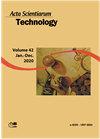地理技术在亚马逊西部Rondônia州养鱼地理信息系统中的应用
IF 0.6
4区 综合性期刊
Q3 MULTIDISCIPLINARY SCIENCES
引用次数: 0
摘要
本研究演示了巴西Rondônia州许可养鱼场的地理信息系统(GIS)。在构建GIS的基础上,结合公路网对养鱼场的位置和分布进行了空间分析;排水;到Rondônia微区,并对密度进行验证。方法学程序包括对数据库(DB)进行建模,数据库的信息来自于Rondônia para Desenvolvimento Ambiental秘书处(SEDAM/RO),该数据库包含在SPRING和ARCGIS 9 Arcmap 9.3软件中处理的许可养鱼场的参考资料。对于空间统计,采用核密度估计。主要的结果是,地理信息系统使搜索有关所研究的养鱼场的数据和信息变得快捷和容易。位于Rondônia州中部地区的冀巴拉本文章由计算机程序翻译,如有差异,请以英文原文为准。
Geotechnologies applied to geographic information system (GIS) of Fish farming in Rondônia state, Western Amazon
This research demonstrated a Geographic Information System (GIS) of licensed fish farms in Rondônia state, Brazil. Based on structuring of the GIS, spatial analyzes of location and distribution of fish farms were carried out in relation to highway network; to drainage; to microregions of Rondônia and the verification of the density. Methodological procedure consisted of modeling the Database (DB), whose information was obtained from Secretaria do Estado de Rondônia para Desenvolvimento Ambiental (SEDAM/RO), which holds the references of licensed fish farms processed in SPRING and ARCGIS 9 Arcmap 9.3 software. For spatial statistics, the Kernel density estimator was applied. The main result is the fact that GIS made it quick and easy to search for data and information about the fish farms studied. The highest density was 4937.64 fish farms per unit area in Ji-Paraná microregion, which is located in the Central region of Rondônia state. In thematic mapping, the fish farms showed some spatial dependencies, as follows: I – They depend on main access, highway BR 364. II – The cluster of fish farms is arranged where there is greater availability of water, that is, they depend on water courses. Therefore, positioning and distribution of fish farms take place in the three main microregions, Ji-Paraná 40.30% of licensed fish farms, followed by microregions of Cacoal 16.02% and Ariquemes 15.87%.
求助全文
通过发布文献求助,成功后即可免费获取论文全文。
去求助
来源期刊

Acta Scientiarum-technology
综合性期刊-综合性期刊
CiteScore
1.40
自引率
12.50%
发文量
60
审稿时长
6-12 weeks
期刊介绍:
The journal publishes original articles in all areas of Technology, including: Engineerings, Physics, Chemistry, Mathematics, Statistics, Geosciences and Computation Sciences.
To establish the public inscription of knowledge and its preservation; To publish results of research comprising ideas and new scientific suggestions; To publicize worldwide information and knowledge produced by the scientific community; To speech the process of scientific communication in Technology.
 求助内容:
求助内容: 应助结果提醒方式:
应助结果提醒方式:


